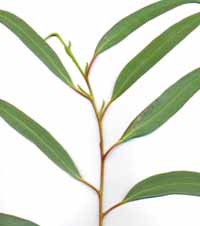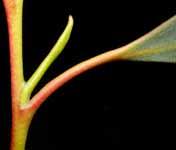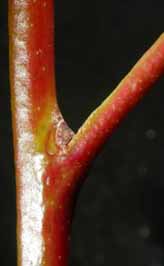Australian eucalypts have again shown how well adapted they are to dealing with bushfires, according to research from Charles Sturt University (CSU) and Charles Darwin University (CDU).
The researchers had previously found that eucalypts have special ‘buds’ that are buried within the bark of their trunks for recovery after intense fire. The researchers have now found primordial buds buried in the leafy canopies capable of fast recovery after lower intensity fires.
“It’s quite amazing how well adapted our eucalypts are to both low and high intensity bushfires,” says Dr Geoff Burrows, a plant research scientist with CSU.
 For the past three years Dr Burrows and colleagues from CDU in the Northern Territory (NT), who are investigating how trees re-sprout after fire, have looked at bud structures in the canopy and under the bark in the trunks of a range of NT trees. The 20 species they are studying, such as rainforest and savannah species include seven eucalypts as well as three close ‘relatives’.
For the past three years Dr Burrows and colleagues from CDU in the Northern Territory (NT), who are investigating how trees re-sprout after fire, have looked at bud structures in the canopy and under the bark in the trunks of a range of NT trees. The 20 species they are studying, such as rainforest and savannah species include seven eucalypts as well as three close ‘relatives’.Dr Burrows said that while scientists have already studied leaf buds in eucalypts - also known as axillary buds -, they have only looked at young seedlings and only to understand why some species formed woody swellings, or lignotubers, in the soil.
Dr Burrows explained that all plants have axillary or leaf buds where the leaf meets the stem. All gardeners depend on these buds. After lightly pruning a plant, it is this reserve of buds that grow and cover the plant with new shoots and leaves.
 “Although they appear tough and rugged eucalypts initially produce an incredibly delicate ‘naked’ bud at the base of each leaf. In most cases this bud just dies and falls to the ground after a couple of weeks,” he said. “In a few cases the bud grows and forms a new branch.”
“Although they appear tough and rugged eucalypts initially produce an incredibly delicate ‘naked’ bud at the base of each leaf. In most cases this bud just dies and falls to the ground after a couple of weeks,” he said. “In a few cases the bud grows and forms a new branch.”When a ‘naked’ bud falls, the eucalypt appears to have lost its ability to re-sprout. However, Dr Burrows has found that eucalypts have a number of minute, back-up or accessory buds - a main one with even smaller ones at its base - buried beneath the surface of the smallest branches. These buds are then protected from being eaten or killed by the heat of a ground fire.
“Most plants have strong, well-formed axillary buds,” said Dr Burrows. “Eucalypts are the only trees I know that let a very delicate bud go out first, see what the situation is, in most cases lets it drop off, but then has a reserve of accessory buds hidden and protected within the smallest branches and twigs.
 “In the NT most bushfires are grass-fires, so the eucalypt canopy doesn’t burst into flames – if it did these buds would be roasted,” said Dr Sean Bellairs from Charles Darwin University.
“In the NT most bushfires are grass-fires, so the eucalypt canopy doesn’t burst into flames – if it did these buds would be roasted,” said Dr Sean Bellairs from Charles Darwin University.“However, you get heat scorch and the leaves shrivel up. With this unique set-up eucalypts are able to successfully re-sprout in the canopy of the tree.
“The eucalypts’ closest relatives have typical axillary buds that are long-lived and found on the surface, again showing just how remarkably different and fire-adapted eucalypts are,” said Dr Bellairs.
"These results are important in understanding why Australia has such a flammable landscape,” said Professor David Bowman, from the University of Tasmania but formerly of CDU.
“Eucalypts, which are the superstructure of the forests, figured how to live with fire millions of years ago and we are still learning some of their tricks.”
Author: Margrit Beemster





Social
Explore the world of social